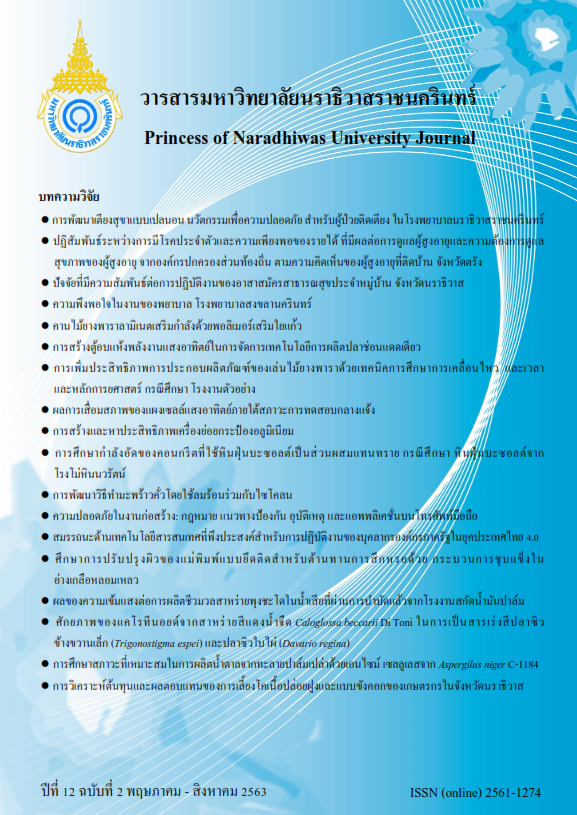The Study of Compressive Strength of Concrete in Case Study using Basalt Dust Aggregate from Nawarat Crushing Plant as Sand Replacement
Keywords:
Basalt dust, Sand, Concrete, Compressive strengthAbstract
The research objectives were to investigate the compressive strength of the concrete, comprising partly in its mixture the basalt dust aggregate from Nawarat crushing plant as case study and to study its application in civil engineering. The basalt dust partially replaces quantity of sand in the concrete mixture were ranged from the ratio of 0, 20, 40, 60, 80, and 100 % (only basalt dust aggregate) by weight. The proportion of cement, sand and rock aggregate was 1:2:4 by weight and the water-cement ratio of the mixture (W/C) was 0.55. The slump of the partially-mixed concrete was 7.0-8.5 cm. The experimental results of this research project found that the compressive strengths at 28 days water curing for different proportions ranged from 173 to 229 kilograms per square centimeter (ksc) (or average value at 200 ksc). The outcomes also indicated that the concrete with 80 percentage of basalt dust in place of sand gave the highest compressive strength at 229 ± 2.90 ksc. The strength of normal concrete was 272 ksc which was higher than 15.8%, compared with the peak at 229 ksc of the partially mixed. For the application viewpoint, the standard of the Department of Public Works and Town & City Planning (DPT) 1101-52 had specified the lowest ultimate compressive strength at 150, 180, 210, and 240 ksc for the concrete type K1 (general civil construction) K2, K3 and K4. Thus, the strengths of concrete comprising of basalt dust as sand replacement for all proportions should comply the standard of concrete. The partly basalt mixed concrete therefore give high potential for the application in various civil constructions.
References
Al-Rawashdeh, M. & Shaqadan, A. (2015) Effect of basalt aggregates and plasticizer on the compressive strength of concrete. International Journal of Engineering & Technology. 4(4), 520-525. Science Publishing Corporation.
ASTM C70-20. (2020). Standard Test Method for Surface Moisture in Fine Aggregate, ASTM International, West Conshohocken, PA.
ASTM C136/C136M-19. (2019). Standard Test Method for Sieve Analysis of Fine and Coarse Aggregates, ASTM International, West Conshohocken, PA.
ASTM C127-15. (2015). Standard Test Method for Relative Density (Specific Gravity) and Absorption of Coarse Aggregate, ASTM International, West Conshohocken, PA.
ASTM C128-15. (2015). Standard Test Method for Relative Density (Specific Gravity) and Absorption of Fine Aggregate, ASTM International, West Conshohocken, PA.
ASTM C29/C29M-17a. (2017). Standard Test Method for Bulk Density (Unit Weight) and Voids in Aggregate, ASTM International, West Conshohocken, PA.
ASTM C143 C143M-15a. (2015). Standard Test Method for Slump of Hydraulic-Cement Concrete, ASTM International, West Conshohocken, PA.
ASTM C192/C192M-19. (2019). Standard Practice for Making and Curing Concrete Test Specimens in the Laboratory, ASTM International, West Conshohocken, PA.
ASTM C39/C39M-20. (2020). Standard Test Method for Compressive Strength of Cylindrical Concrete Specimens, ASTM International, West Conshohocken, PA.
Blyth, F.G.H. & Freitas de, M.H. (2006) A Geology for Engineers. (5th Ed.). CRC Press. Chovichian, V. (2001). Concrete Technology. Bangkok: P. Sampanpanich. (In Thai).
Farndon, J. (2006). The Complete Guide to Rocks & Minerals. Anness Publishing Ltd. http://www.knc2001.com /files/knc2001.pdf.
Kingkaew, R., Chaijit, P., Chotchuay, V. & Chaihan, J. (2015). The Substitution of Sand by Stonedust in Ready Mixed Concrete. Journal of Southern Technology. 8(2), 55-61.
Komenthammasopon, S. (2012). The Investigation of Compressive Strength of Concrete in Case Study using Granite Dust from Thai Crushing Plant as Replacement for Sand. Princess of Naradhiwas University Journal. 4(3), 44-53.
Komenthammasopon, S. (2013). The Investigation of Compressive Strength of Concrete in Case Study using Sieved Granite Dust from Thai Crushing Plant as Replacement for Sand. Princess of Naradhiwas University Journal. 5(1), 49-60.
Leroy, M.N., Guy Molay T.G., Joseph N., Colince, F.M. & Bienvenu J.N. (2017). A Comparative study of concrete using metamorphic, igneous, and sedimentary rocks (crushed gneiss, crushed basalt, alluvial sand) as fine aggregate. Journal of Architectural Engineering Technology, 6(1), 1-6.
Nijanpansri, P. (2005). Research report on the use of dust aggregate as sand replacement. National Research Council of Thailand. (In Thai).
Nokkaew, N. (2015). Highway Engineering. (5th Ed.) Faculty of Engineering, Rajamangala University of Technology Thanyaburi. (In Thai).
Standard of the Department of Public (2020) Works and Town & City Planning (DPT) 1101-52. Retrived 13 January 2020 from: http://www.dpt.go.th
Suresh, N., & Manjunatha M. (2016). Effect of different types of fine aggregates on mechanical properties of concrete – A review. The Indian Concrete Journal, 69-71.
Suwansukroj, N., Pansaengdao, T. & Termsak, S. (1998). Compressive Strength of Concrete Composed of Crushed Dust Instead of Sand. KKU Engineering Journal. 25(2), 1-5.
Ukpata, O.J., Ephraim, E.M. & Akeke A.G. (2012). Compressive strength of concrete using lateritic sand and quarry dust as fine aggregate. APRN Journal of Engineering and Applied Sciences, 7(1), 81-92.
West, R.T. (2010). Geology Applied to Engineering. Waveland Press, Inc.




